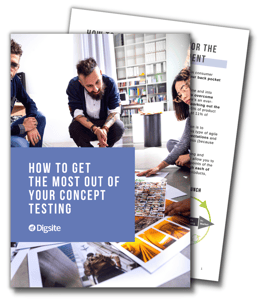Whether you’re a veteran in the industry or just starting out in consumer insights, there are a handful of best practices to keep in your back pocket for your next project. In our last webinar, Digsite CEO Monika Rogers provided an overview of these top tips on how to make your next concept-testing market research project a success. You can watch a recording of the webinar here.
We all feel that pressure to get new products over the finish line and into market as quickly as possible, but there are big challenges to overcome before you see your hard work make it to the store shelf. There’s an ever-present tension between launching a product on time and working out the kinks to deliver a big success. According to Gartner, around 45% of product launches are delayed by at least a month. At the same time, just 11% of organizations achieve all their defined internal launch targets.
One way to effectively address this tension within an organization is to concept test within a collaborative learning environment. This type of agile concept testing builds through development to set the right expectations and understand what your consumers are thinking earlier in the process (because it’s much harder to make changes later).
Effective concept testing comes down to the idea of building, testing and learning in a very iterative and holistic way. Agile learning loops allow you to see the progress you've made while adjusting throughout various points of the concept development process. By optimizing your testing through each of the three stages of development, you can create more effective products, faster.
.png?width=779&name=Product%20Concept%20Fit%20(1).png)
Read more about building the perfect learning loop here.
How to Optimize Testing for the Three Phases of Development
Phase I: Explore
In this phase, you may have concrete data on customer problems, internal information on in-market performance or custom research to identify opportunities and brainstorm ideas. But, you still have to frame those abstract problems and potential solutions into concepts in a way that consumers can give feedback.
In this phase, you need to:
- Find multiple concepts to solve an important consumer problem.
- Build more and better concepts based on customer feedback.
- Converge based on overall breadth and depth of consumer appeal.
Phase II: Build
While the objectives listed below are all common, it’s very easy to go off the rails during this phase when it comes to the number of concepts, testing methods and complexity. Having a solid footing on what you’re trying to understand – and the level of granularity at which you’re trying to understand it – will help keep your timelines in check.
In this phase, you need to:
- Optimize the concept with tangible product attributes that solve the problem.
- Optimize even further with positioning that maximizes the emotional appeal to the consumer.
- Pick the winning idea(s) for launch.
Phase 3: Launch
In this last phase, pay close attention to the way your product is delivering compared to the first exploratory phase of your research. Is the product meeting the original expectations? Does the experience of the product fulfill the concept? Does the advertising, messaging and marketing match with what you created? Don’t overlook this last step that will sell your idea in the retail space and bring your concept into the hands of the consumer.
In this phase, you need to:
- Tie your final concept to a clear forecast model.
- Validate that your launch delivers on your concept benefits.
- Build a strong story for your sales or distribution partners to grab onto.
Success Factors for Agile Concept Testing
If you want faster development cycles, less rework and better-quality outcomes, then agile concept testing is right for you. Effective concept testing, whether qualitative or quantitative, gives teams the insights they need to make critical mid-course decisions. Successful concept testing will lead to improved product development, optimized marketing strategy, reduced time to market and will keep customers coming back for more.
By building these solutions together in a way that’s collaborative for you and your innovation team, you can see results together and iterate into the next phase. We’ve seen common themes throughout our most successful projects, which all start with setting the team’s expectations of the research objective early on. Remember that qualitative testing helps ensure that good ideas don’t get killed. You can save a good deal of time by testing things that aren’t perfectly polished, and most importantly, build in time for you and your team to iterate from your learnings.
Want to get the full story? Read our new eBook,
How to Get the Most Out of Your Concept Testing.
See real examples from companies who have successfully launched new products and read our top tips for testing at each stage.





